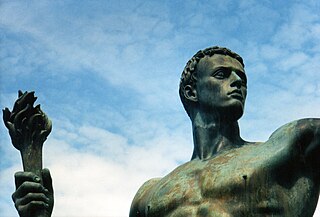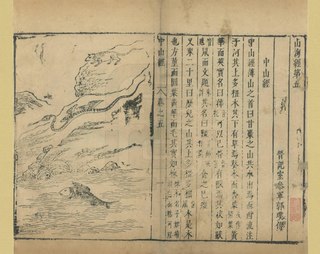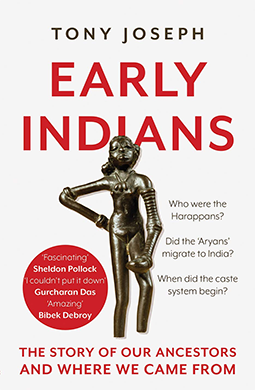
The Proto-Indo-Europeans are a hypothetical prehistoric ethnolinguistic group of Eurasia who spoke Proto-Indo-European (PIE), the reconstructed common ancestor of the Indo-European language family.

The master race is a pseudoscientific concept in Nazi ideology in which the putative "Aryan race" is deemed the pinnacle of human racial hierarchy. Members were referred to as "Herrenmenschen".

David Frawley, also known as Vamadeva Shastri is an American writer, astrologer, teacher (acharya) and a proponent of Hindutva.

Subhash Kak is an Indian-American computer scientist and historical revisionist. He is the Regents Professor of Computer Science Department at Oklahoma State University–Stillwater, an honorary visiting professor of engineering at Jawaharlal Nehru University, and a member of the Indian Prime Minister's Science, Technology and Innovation Advisory Council (PM-STIAC).

Indo-Aryan peoples are a diverse collection of peoples speaking Indo-Aryan languages in the Indian subcontinent. Historically, Aryans were the Indo-Iranian speaking pastoralists who migrated from Central Asia into South Asia and introduced the Proto-Indo-Aryan language. The early Indo-Aryan peoples were known to be closely related and belonging to the same Indo-Iranian group that have resided north of the Indus River; an evident connection in cultural, linguistic, and historical ties. Today, Indo-Aryan speakers are found south of the Indus, across the modern-day regions of Bangladesh, Nepal, eastern-Pakistan, Sri Lanka, Maldives and northern-India.
Nordicism is an ideology which views the historical race concept of the "Nordic race" as an endangered and superior racial group. Some notable and influential Nordicist works include Madison Grant's book The Passing of the Great Race (1916); Arthur de Gobineau's An Essay on the Inequality of the Human Races (1853); the various writings of Lothrop Stoddard; Houston Stewart Chamberlain's The Foundations of the Nineteenth Century (1899); and, to a lesser extent, William Z. Ripley’s The Races of Europe (1899). The ideology became popular in the late-19th and 20th centuries in Germanic-speaking Europe, Northwestern Europe, Central Europe, and Northern Europe, as well as in North America and Australia.
African American literature is the body of literature produced in the United States by writers of African descent. It begins with the works of such late 18th-century writers as Phillis Wheatley. Before the high point of enslaved people narratives, African American literature was dominated by autobiographical spiritual narratives. The genre known as slave narratives in the 19th century were accounts by people who had generally escaped from slavery, about their journeys to freedom and ways they claimed their lives. The Harlem Renaissance of the 1920s was a great period of flowering in literature and the arts, influenced both by writers who came North in the Great Migration and those who were immigrants from Jamaica and other Caribbean islands. African American writers have been recognized by the highest awards, including the Nobel Prize given to Toni Morrison in 1993. Among the themes and issues explored in this literature are the role of African Americans within the larger American society, African American culture, racism, slavery, and social equality. African-American writing has tended to incorporate oral forms, such as spirituals, sermons, gospel music, blues, or rap.

The Classic of Mountains and Seas, also known as Shanhai jing《山海经》, formerly romanized as the Shan-hai Ching, is a Chinese classic text and a compilation of mythic geography and beasts. Early versions of the text may have existed since the 4th century BCE, but the present form was not reached until the early Han dynasty. It is largely a fabulous geographical and cultural account of pre-Qin China as well as a collection of Chinese mythology. The book is divided into eighteen sections; it describes over 550 mountains and 300 channels.
Edwin Francis Bryant is an American Indologist. Currently, he is professor of religions of India at Rutgers University. He published seven books and authored a number of articles on Vedic history, yoga, and the Krishna tradition. In his research engagements, he lived several years in India where he studied Sanskrit and was trained with several Indian pundits.

Navaratna Srinivasa Rajaram was an Indian academic.He is notable for propounding the "Indigenous Aryans" hypothesis, asserting that the Vedic period was extremely advanced from a scientific view-point, and claiming of having deciphered the Indus script. Academics find his scholarship to be composed of dishonest polemics in service of a communal agenda.

The Indo-Aryan migrations were the migrations into the Indian subcontinent of Indo-Aryan peoples, an ethnolinguistic group that spoke Indo-Aryan languages. These are the predominant languages of today's Bangladesh, Maldives, Nepal, North India, Eastern Pakistan, and Sri Lanka.

Hermann Georg Jacobi was an eminent German Indologist.

Braj Basi Lal was an Indian writer and archaeologist. He was the Director General of the Archaeological Survey of India (ASI) from 1968 to 1972 and has served as Director of the Indian Institute of Advanced Studies, Shimla. Lal also served on various UNESCO committees.
The Baudhayana Shrauta Sutra is a Late Vedic text dealing with the solemn rituals of the Taittiriya Shakha school of the Krishna Yajurveda that was composed in eastern Uttar Pradesh during the late Brahmana period. It was transmitted both orally and through manuscript copying. It was printed in 1904-23 by The Asiatic Society, translated by C.G. Kashikar in part in his "Srautakosa", and as a whole later on. It was edited by Willem Caland.

Nazi archaeology was a field of pseudoarcheology led and encouraged by various Nazi leaders and Ahnenerbe figures, such as Adolf Hitler and Heinrich Himmler, which directed archaeologists and other scholars to search Germany's archeological past in order to find material evidence supporting an advanced, Aryan ancestry as alleged and espoused by the ultranationalist Nazi Party.

Indigenous Aryanism, also known as the Indigenous Aryans theory (IAT) and the Out of India theory (OIT), is the conviction that the Aryans are indigenous to the Indian subcontinent, and that the Indo-European languages radiated out from a homeland in India into their present locations. It is a "religio-nationalistic" view on Indian history, and propagated as an alternative to the established migration model, which considers the Pontic–Caspian steppe to be the area of origin of the Indo-European languages.

Elleke Boehmer, FRSL, FRHistS is Professor of World Literature in English at the University of Oxford, and a Professorial Governing Body Fellow at Wolfson College. She is an acclaimed novelist and a founding figure in the field of Postcolonial Studies, internationally recognised for her research in colonial and postcolonial literature and theory. Her main areas of interest include the literature of empire and resistance to empire; sub-Saharan African and South Asian literatures; modernism; migration and diaspora; feminism, masculinity, and identity; nationalism; terrorism; J. M. Coetzee, Katherine Mansfield, and Nelson Mandela; and life writing.

The Arctic Home in the Vedas by Indian nationalist, teacher and independence activist Bal Gangadhar Tilak is a 1903 book on the origin of the Indo-European peoples, which he in accordance with academic consensus in his time, refers to as Aryans for the totality of his book. Based on his analysis of Vedic hymns, Avestic passages, Vedic chronology and Vedic calendars, Tilak argued that the North Pole was the original home of Aryans during the pre-glacial period, which they left due to climate changes around 8000 B.C., migrating to the Northern parts of Europe and Asia.

Aryan or Arya is a term originally used as an ethnocultural self-designation by Indo-Iranians in ancient times, in contrast to the nearby outsiders known as 'non-Aryan'. In Ancient India, the term ā́rya was used by the Indo-Aryan speakers of the Vedic period as an endonym (self-designation) and in reference to a region known as Āryāvarta, where the Indo-Aryan culture emerged. In the Avesta scriptures, ancient Iranian peoples similarly used the term airya to designate themselves as an ethnic group, and in reference to their mythical homeland, Airyanǝm Vaēǰō. The stem also forms the etymological source of place names such as Alania and Iran.

Early Indians: The Story of Our Ancestors and Where We Came From is a 2018 nonfiction book written by Indian journalist Tony Joseph, that focuses on the ancestors of people living in South Asia today. Joseph goes 65,000 years into the past—when anatomically modern humans first made their way from Africa into the Indian subcontinent. The book relies on research findings from six major disciplines: history, archaeology, linguistics, population genetics, philology, and epigraphy, and includes path-breaking ancient DNA research of recent years. It also relies on the extensive study titled "The Genomic Formation of Central and South Asia", co-authored by 92 scientists from around the world and co-directed by geneticist David Reich of Harvard Medical School, in which ancient DNA was used. The book has been translated into Tamil, Hindi, Odia, Telugu, Marathi, Malayalam, Gujarati, and other languages.











